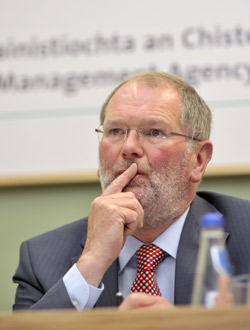The end of the beginning

The outlines of a deal on our bank debt, an interest rate cut and a successful debt auction. Our economic crisis may not be over but for the first time in almost five years it is possible to begin to hope. Dan White reports
11 July 2012
Next month marks the fifth anniversary of the beginning of the most severe economic crisis to hit the world economy since the 1930s. What began as the “credit crunch” (remember that?), has gradually morphed into the “Great Recession”.
In this country the fall-out from the Great Recession bankrupted the Irish state and banks while globally we have had the fallout from the collapse of Wall Street investment bank Lehman in September 2008 and the seemingly never-ending eurozone crisis.
The financier Warren Buffett once famously observed that when the tide goes out you get to see who has been swimming naked. Turns out that there was quite a lot of financial skinny-dipping going on, not least in Ireland, during the years leading up to 2007.
We in Ireland have been particularly badly hit by the Great Recession.
Tsunami of cheap credit
In the years following the formation of the euro at the beginning of 1999 a tsunami of cheap credit flowed into the country as British and mainland European banks lent to their Irish counterparts. The Irish banks in turn lent this money to builders, property developers and homeowners.
Irish bank lending rose almost seven-fold between 1997 and 2007 while property prices more than trebled over the same period. This property bubble also fuelled an explosion in tax revenues.
This meant that, when the music stopped in 2007, we were particularly vulnerable. Not alone were the banks up to their oxters in bad property loans, property-related tax revenues collapsed leaving the government facing a huge budget deficit at the same time as the banks required huge injections of fresh capital to plug the holes in their balance sheets.
Matters were made even worse when the previous government unconditionally guaranteed the bonds and deposits of the Irish-owned banks in September 2008.
The rest is, as they say, history. By November 2010 the then Irish government was forced to go cap in hand to the EU and the IMF seeking a bailout.
Paying a high price
The Irish people have paid a very, very heavy price since the bubble economy burst five years ago. The jobless rate has risen from 4.3% to 14.8% with 360,000 jobs disappearing. A massive 181,000 of these vanished jobs were in the bloated construction sector where the number of jobs has fallen from a peak of 284,000 to just 103,000 over the past five years.
Retailing has also been badly hit with approximately 50,000 jobs disappearing.
Even for those who have been lucky enough to keep our jobs, times have been tough. We have endured five hairshirt budgets since October 2008 which have taken a cumulative €25bn out of the economy in tax increases and public spending cuts with at least three more budgets, which are expected to take a further €11bn out of the economy to come.
A chink of light?
However, after all the doom and gloom of recent years have we witnessed the first chinks of light?
At their summit at the end of June, EU leaders surprised everyone by agreeing in principle to allow the ESM, the new EU bailout fund, to recapitalise failing banks directly rather than, as is the case at present, lending the money to a eurozone member country which in turn pumps the money into its banks.
The problem with this approach, as we in this country learned to our cost, is that it effectively converts private bank debt into sovereign debt. It was the €63bn cost of recapitalising the banks which locked Ireland out of the international bond markets in the autumn of 2010 and forced us to seek a bailout.
The new policy agreed last month would in contrast keep the cost of recapitalising the banks off the sovereign’s balance sheet. If such a policy were to be made retrospective and some means could be found to shift all or part of the €63bn we have poured into the bottomless pit otherwise known as the Irish banking system, then a huge chunk could be knocked off our government debt figure, which is projected to hit €186bn by the end of this year.
A significant reduction in our debt figure would of course have major implications for our credit-worthiness. While the timing may have been coincidental, the agreement on bank debt was followed within a week by the first auction of Irish government debt since autumn 2010 when the NTMA sold €500m of three-month treasury bills. The auction was three-times over-subscribed and the bonds were sold at a yield of 1.8%, the equivalent of an annual yield of about 7.4%.
Interest rate cut
On the same day as the successful bond auction the ECB provided more good news when it cut official eurozone interest rates to just 0.75%, the lowest official eurozone interest rates have been since the formation of the single currency more than 13 years ago.
Announcing the rate cut, ECB president Mario Draghi pointedly stated that the bank saw no danger of inflation in the months ahead. His remarks can probably be interpreted as meaning that the non-German majority on the ECB council will push through further rate cuts over the next few months.
So is the crisis over? After five years of blood, sweat and tears is time to break out the bubbly?
Probably not yet. The deal on banking debt is after all only an agreement “in principle”. Will the Germans along with their Dutch and Finnish allies seek to recover at the drafting stage what they lost at the negotiating stage?
The successful debt auction should also be treated with caution. These weren’t long-term bonds but short-term treasuries which fall due for repayment in October. Despite the issue being over-subscribed, this was little more than a token return to the debt markets. The real test will come, probably early next year, when the NTMA seeks to find buyers for three, five or ten-year bonds.
Tentative road to recovery
And as for lower interest rates, unless you are lucky enough to have a tracker mortgage the fact is that Irish interest rates have long since decoupled from official ECB rates.
So these developments, welcome and all as they are, are no more than a very tentative first step on the road to recovery. Or to paraphrase Winston Churchill’s remarks after the British victory over the Afrika Corps at the Battle of El-Alamein. Not the beginning of the end but the end of the beginning.



 Print
Print





Fans 0
Followers